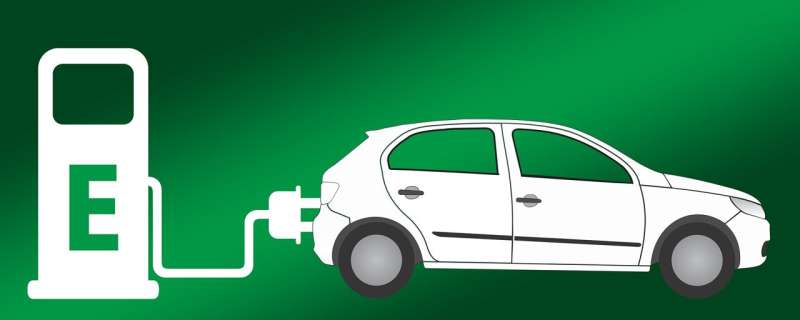A new look at the electric vehicle supply chain as battery-powered cars hit the roads en masse

Electric vehicle (EV) adoption is beginning to take off, and scientists and policymakers want to know how the battery supply chain will accommodate and reinforce increasing demand. A new wave of investment in battery development and manufacturing of next-generation EV battery packs in the U.S. will help America hit the goal of roughly 10 million new EVs sold per year by 2030.
When people think about scientists working on these batteries to support a decarbonized future, they might imagine men and women working in labs to develop new chemistries. That’s part of the story, but not all. What happens next? Where are these batteries produced? Does the U.S. have enough production capacity to support widespread EV adoption? And once the batteries are made and put into cars, how do we know whether we have enough charging stations, in the right places, to keep them running?
Scientists at the U.S. Department of Energy’s (DOE) Argonne National Laboratory are trying to answer these and other questions.
In a series of new reports, Argonne researchers have studied trends in EV manufacturing and adoption, analyzed the supply chain and determined the impacts of more widespread EVs in terms of displaced petroleum consumption and greenhouse gas emissions.
“We are beginning to see EVs really gain a broader foothold in the market, and this trend will only accelerate throughout the remainder of the decade,” said Argonne energy and environmental analyst Dave Gohlke. “From creating thousands of new American jobs to helping to decarbonize our country and combat the effects of climate change, the effects of increased investment and adoption of EVs will help shape our economy and our environment.”
According to Joann Zhou, interim director of the System Assessment Center at Argonne and manager of the center’s mobility and deployment group, the 2022 Inflation Reduction Act provides tax incentives for domestically produced EVs that are designed to promote an American EV manufacturing pipeline. “The Inflation Reduction Act marks an important milestone for getting more EVs produced domestically,” she said.
Argonne researchers have long tracked EV sales as well as announcements of new investments in battery and EV manufacturing. “For every EV manufactured in the United States, we’ve been asking, ‘who made the battery and where,’ and ‘who assembled the car and where,'” Gohlke said.
According to Gohlke, since last year there has been roughly one new announcement of a new battery development or EV manufacturing project every few days, a dramatic increase even since the beginning of the pandemic. “A lot of these announcements are substantial in terms of the dollars being allocated or the number of jobs that these companies plan to fill,” said Argonne postdoctoral researcher Xinyi Wu.
Gohlke explained that Argonne’s chief goal is to supply DOE and others with information about the impacts of accelerated EV manufacture and adoption. “We’re very interested in the number of jobs that will be created by all of this investment because that’s what people can directly relate to, and we can also make a quantitative analysis of the potential gasoline and greenhouse gas reductions.”
“Tracking and analyzing this data is essential for helping DOE and the Biden Administration meet their decarbonization goals,” Gohlke said. In order to help reduce the costs of producing EVs, companies are tending to colocate battery manufacturing facilities in states that contain vehicle assembly plants. “The EV community and automotive manufacturers have done a lot of thinking as to how to most efficiently build these vehicles,” Zhou said. “Where there have been major investments in this technology, a ‘battery belt’ is emerging.”
Argonne research identified Michigan and Kentucky as key states for EV battery production through 2030, with each of these states supplying between 97 and 136 gigawatt-hours’ worth of battery capacity by the end of the decade. Georgia, North Carolina, Ohio, Tennessee and Kansas would also be important contributors.
In total, domestic EV battery manufacturing capacity will increase by almost 20-fold between 2021 and 2030, according to a November 2022 Argonne report. A map on the DOE website based on Argonne’s work shows the locations of new U.S. battery manufacturing and supply chain investments.
Zhou also pointed to battery recycling as a way to domestically obtain critical materials needed for new batteries. “Argonne has a long history in battery recycling, and our efforts there could fit in nicely in helping to secure the supply chain,” she said. The ReCell Center, a multilab center funded by DOE and led by Argonne, is exploring battery recycling technologies to establish a circular battery ecosystem.
More information:
publications.anl.gov/anlpubs/2022/11/178584.pdf
Citation:
A new look at the electric vehicle supply chain as battery-powered cars hit the roads en masse (2023, May 5)
retrieved 5 May 2023
from https://techxplore.com/news/2023-05-electric-vehicle-chain-battery-powered-cars.html
This document is subject to copyright. Apart from any fair dealing for the purpose of private study or research, no
part may be reproduced without the written permission. The content is provided for information purposes only.
For all the latest Technology News Click Here
For the latest news and updates, follow us on Google News.

